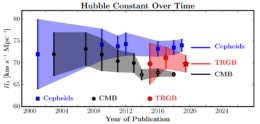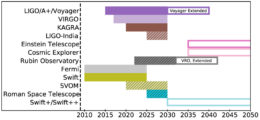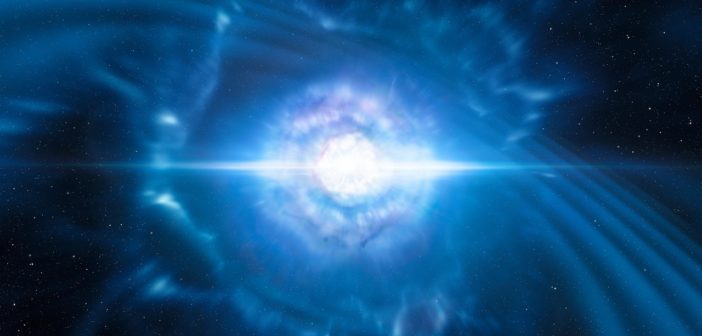Collisions of neutron stars and black holes provide insights beyond stellar evolution: these mergers may also be the key to unlock precise measurements of the cosmological parameters that describe our universe. A recent study explores what we can hope to learn with multimessenger cosmology in the next few decades.
Pinning Down Parameters

Measurements of the Hubble constant via different methods show a discrepancy in measured value that has only grown over time. [Freedman et al. 2019]
Unfortunately, different measurement techniques produce a wide spread in values for these parameters. Scientists have long waited for a new, independent approach that will provide a resolution to the tension between past measurements. Now, in the age of gravitational astronomy, we have one: the standard siren technique.

Diagram illustrating the stages of a neutron-star collision. In the model, 1) two neutron stars inspiral, 2) they merge and produce a gamma-ray burst lasting a tenth of a second, 3) a small fraction of their mass is flung out and radiates on timescales of weeks as a kilonova, 4) a massive neutron star or black hole with a disk remains after the event. [NASA, ESA, and A. Feild (STScI)]
Insights from Sirens
We’ve previously discussed the use of dark sirens — black hole–black hole mergers — as a tool to measure cosmological parameters. Standard sirens — the mergers of neutron stars with either black holes or other neutron stars — are a similarly useful tool, but they rely on multimessenger observations rather than only gravitational waves.
The idea is straightforward: by simultaneously observing the gravitational-wave and electromagnetic signals from these explosive mergers, we can obtain both an absolute distance scale and a redshift measurement for the source. This combination allows us to obtain an independent measurement of cosmological parameters — and the more of these joint detections we make, the more precise our measurements will be.
But implementing this approach efficiently requires some planning. What’s the best observing strategy to ensure we can pin these parameters down with the gravitational-wave and electromagnetic observatories planned for the next few decades? A new study led by Hsin-Yu Chen (Harvard University and MIT) explores this question.
The Promise of Future Detectors

Schematic timeline of existing (solid), funded (hatched), and proposed (open) GW and EM facilities over the next three decades. Swift+/Swift++ are hypothetical future gamma-ray satellites. [Chen et al. 2021]
- Three eras of gravitational-wave detectors with increasing sensitivity (A+, Voyager, and Cosmic Explorer)
- Wide-field survey telescopes like the Vera Rubin Observatory that can detect kilonovae, the optical and infrared counterparts of mergers involving neutron stars.
- High-energy observatories like Swift and its successors to detect short gamma-ray bursts, a highly directional but bright counterpart to mergers.

Uncertainty in the measurement of H0 for a variety of different observing strategies. Orange bars indicate the fraction of total observing time available to VRO for each kilonova scenario. [Adapted from Chen et al. 2021]
Using these calculations, the authors outline an observing strategy for the next three decades. They demonstrate that with clever use of resources, we could soon reach sub-percent-level precision on H0 and tight constraints on the amount and form of dark energy in the universe. This work shows the great potential ahead using standard sirens for precision cosmology.
Citation
“A Program for Multimessenger Standard Siren Cosmology in the Era of LIGO A+, Rubin Observatory, and Beyond,” Hsin-Yu Chen et al 2021 ApJL 908 L4 6. doi:10.3847/2041-8213/abdab0
